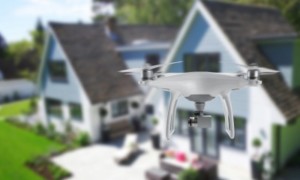 For most real estate agents, marketing with aerial photography or video has been considered an extravagance reserved only for high-dollar properties and luxury homes. However, a new federal policy now permits Realtors to market properties at all price-points in ways that were cost-prohibitive in the past. The “Small Unmanned Aircraft Rule,” expands the possibility for commercial drone usage for the real estate industry—without the previous restrictions and complicated application process. With this new accessibility, aerial photography and video are shaping up to be the next evolution of transformative real estate marketing solutions.
For most real estate agents, marketing with aerial photography or video has been considered an extravagance reserved only for high-dollar properties and luxury homes. However, a new federal policy now permits Realtors to market properties at all price-points in ways that were cost-prohibitive in the past. The “Small Unmanned Aircraft Rule,” expands the possibility for commercial drone usage for the real estate industry—without the previous restrictions and complicated application process. With this new accessibility, aerial photography and video are shaping up to be the next evolution of transformative real estate marketing solutions.
While video has already proven its value for Realtors, drone footage can now deliver a better value proposition. Currently, 70% of home buyers used video to tour the inside of a home. In addition, homes listed with video receive four times more inquiries than those without video. But, now that it is fairly simple to obtain a remote pilot certificate from the Federal Aviation Administration (FAA) for a mere $150 by studying independently and taking a test on basic aeronautical rules and concepts. It’s a simple matter of supply and demand: With more people positioned to provide aerial footage of properties, the costs integrating it into an agent’s online marketing strategy will inevitably go down.
In an increasingly competitive market landscape, drone photography and video offers a unique approach for differentiating an agent’s services. Aerial shots provide more depth and dimension than standard street level photography, telling a story about the home, neighborhood, and surrounding area while increasing the emotional connection of prospect. This added-value can create an upscale feel for even modest home listings. But, drone imagery not only makes a listing shine above the others, it also showcases an agent’s marketing thought leadership.
Of course, as with any disruptive technology, early adopters of drone photography and videography will gain the most competitive advantage—until consumers come to expect it as a standard service offered by all agents. Research shows that there’s a first-mover advantage to technology adoption; pioneers are more likely to experience increased revenue and market share. Other Realtors will follow suit as the technology bears marketing results. As Will Caldwell, CEO of the real estate technology company Rivolix, predicts:
“Aerial photography will become another line item under the photos and virtual tour column when marketing a listing. Consumers will begin to demand it, as there is no question more people will enjoy watching it.”
Driving toward that moment, an industry-wide opportunity exists for agents to increase service levels with comparable marketing dollars exists.
Broader industry uptake of drone photography and video is not only possible but practical now that the legal roadblocks have been lifted. Aerial footage offers the advantage of higher quality and more detailed property images that appeal to clients. With the price point imminently decreasing, adoption of this online marketing solution makes business sense. Hard-won legal access to drone technology is poised to dramatically change the way Realtors engage online prospects.





It’s interesting that real estate videos shot with drones get more inquiries than those without. I’m planning on selling my house soon and I want it to sell as fast as possible so I can move in a new one. Hiring a real estate company that uses drones in their promotional videos sounds like a good idea.